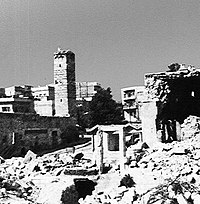Nur al-Din Mosque
Zengid era mosque of Hamas in Syria
35°8′6″N 36°45′9″E / 35.13500°N 36.75250°E / 35.13500; 36.75250The Nur Al-Din Mosque (Arabic: جَامِع نُور ٱلدِّين, romanized: Jāmiʿ Nūr ad-Dīn, transliteration: Jami Nur al-Din) is a Zengid-era mosque in Hama, Syria.[1] It was founded by Nur al-Din in 1163-64 CE. It also contained a historic minbar from the same date, which is now held at the local Hama Museum.[2]
The mosque was profoundly damaged in the 1982 shelling of the city and subsequently restored to its current state.


References
Bibliography
- Rihawi, Abdul Qader (1979). Arabic Islamic Architecture: Its Characteristics and Traces in Syria. Publications of the Ministry of Culture and National Leadership.
- v
- t
- e
- Aqsab Mosque
- Darwish Pasha Mosque
- Hanabila Mosque
- Ibn 'Arabi Mosque (Salimiyya Mosque)
- Murad Pasha Mosque
- Sayyidah Ruqayya Mosque
- Sinan Pasha Mosque
- Sulaymaniyya Takiyya Mosque
- Umayyad Mosque
- Yalbugha Mosque




- Abu'l-Fida Mosque
- Nur al-Din Mosque
- Great Mosque of Hama
- Omari Mosque










